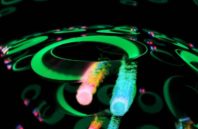The smallest amount of light you can have is one photon, so dim that it’s pretty much invisible to humans. While imperceptible, these tiny blips of energy are useful for carrying quantum information around. Ideally, every quantum courier would be the same, but there isn’t a straightforward way to produce a stream of identical photons. This is particularly challenging when individual photons come from fabricated chips.
Now, researchers at the Joint Quantum Institute (JQI) have demonstrated a new approach that enables different devices to repeatedly emit nearly identical single photons. The team, led by JQI Fellow Mohammad Hafezi, made a silicon chip that guides light around the device’s edge, where it is inherently protected against disruptions. Previously, Hafezi and colleagues showed that this design can reduce the likelihood of optical signal degradation. In a paper published online on Sept. 10 in Nature, the team explains that the same physics which protects the light along the chip’s edge also ensures reliable photon production.
Single photons, which are an example of quantum light, are more than just really dim light. This distinction has a lot to do with where the light comes from. “Pretty much all of the light we encounter in our everyday lives is packed with photons,” says Elizabeth Goldschmidt, a researcher at the US Army Research Laboratory and co-author on the study. “But unlike a light bulb, there are some sources that actually emit light, one photon at time, and this can only be described by quantum physics,” adds Goldschmidt.

 (585) 768-2513
(585) 768-2513

